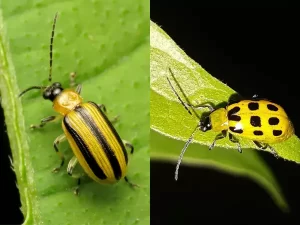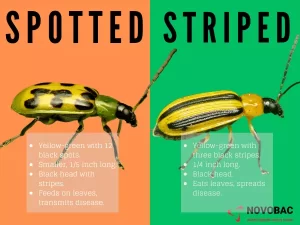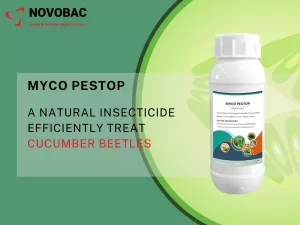Cucumber Beetle Control: 8 Effective Strategies for Gardeners
Cucumber beetles, those tiny but formidable foes of the garden, can wreak havoc on your precious cucumber and squash plants. With their insatiable appetite for leaves and their ability to transmit diseases, these pests are a nightmare for home gardeners.
This blog post will guide you on how to get rid of cucumber beetles naturally and protect your garden from their attacks. Don’t worry, we’ve got you covered.
Cucumber Beetle Damage
Cucumber beetles form the most dangerous threats to cucumber plants as they are quite an annoying pest. The striped or spotted leaf-footed beetles are some of the common insects that feed on the leaves, flowers, and fruits on cucumber plants, thus leaving behind untidy holes and jagged edges on the leaves.

In addition to the above-mentioned transmitted diseases the beetles can also transmit bacterial wilt disease, the cucumber mosaic virus, a factor that further complicates the overall damage extent. Signs of a beetle infestation are feeding damage that can be detected on leaves and stems. Also, the plants will look stunted and wilted. Management tactics are particularly about handling rotation of crops, planting earlier to beat out the beetles, using floating covers for protection and applying pesticides or beneficial fungi or nematodes to target where the beetles actually grow.
What does cucumber beetle damage look like?
Cucumbers are likely to be affected by cucumber beetle attack, as indicated by characteristic signs. Bugs, both striped and spotted sorts of, take irregular holes off cucumber leaves so that the edges of foliage are jagged and damaged. The stems and fruits likewise can feature scarring and small beetle’s feeding puncture wounds.
The worst outbreaks of weevils leave behind nothing but the veins of leaves; whole leaves may be skeletonized. Likewise, cucumber plants can display symptoms of bacterial wilt of cucumber mosaic virus, which serve as a vehicle for transmitting such diseases. In the end, the cucumber beetle damage can cause various effects such as stunted growth, lower yields and poor-quality fruit and require close monitoring and management thus, underscoring why vigilance and good management are a must.

1. Identifying the Culprits:
Before you can effectively combat the insects, it’s essential to know your enemy. Two common types are the striped beetle and the spotted beetle. Understanding their appearance and behavior will help you detect them early.
2. Early Detection and Monitoring:
Beetles on cucumber are most active during the spring and early summer, so start monitoring your garden early in the season. Look for damaged leaves and the beatles themselves. Yellow sticky traps and visual inspections can help you keep tabs on their presence.
3. Cultural Control Methods:
- Crop Rotation: Implement a crop rotation plan to reduce the buildup of beetles in the soil. Avoid planting cucumbers, squash, or related crops in the same location each year.
- Timing: Plant your cucumbers and squash a bit later in the season to avoid peak insect activity.
- Companion Planting: Some plants, like radishes and nasturtiums, can deter insects when planted near your vulnerable crops.
4. Mechanical Control Methods:
- Handpicking: Regularly inspect your plants and pick off any insects you find. Drop them into a bucket of soapy water to dispose of them.
- Floating Row Covers: Use floating row covers to physically block the insects from accessing your plants. Be sure to remove the covers when the plants need pollination.
5. Organic Pest Management:
- Neem Oil: Neem oil is a natural insecticide that can help cucumber beetle control.
- Diatomaceous Earth: Use food-grade diatomaceous earth as a barrier around your plants to deter the pests.
6. Organic Cucumber Beetle Control:
Biological control methods are an eco-friendly way for cucumber beetle control while maintaining a healthy garden ecosystem.
a. Parasitic Wasps (Braconid and Chalcid Wasps):
- Introduction: Parasitic wasps are natural predators of beetles. They lay their eggs inside the beetle larvae, ultimately leading to their demise.
- How to Attract: Plant nectar-rich flowers like dill, fennel, or Queen Anne’s lace near your cucumber and squash plants. These flowers will attract adult parasitic wasps.
- Considerations: Ensure you don’t use broad-spectrum pesticides, as they can harm both insects and beneficial parasitic wasps.
b. Beneficial Nematodes (Steinernema feltiae):
- Introduction: Beneficial nematodes are tiny roundworms that attack beetle larvae in the soil.
- Application: Mix the nematodes with water and apply them to the soil around the base of your cucumber and squash plants. Follow the package instructions for the correct application method.
- Timing: Apply nematodes early in the growing season when the larvae are most vulnerable in the soil.
c. Myco Pestop, a Pesticide for Cucumber Beetles:
- Introduction Cucumber beetle insecticide Myco Pestop is with Metarhizium anisopliae fungus. It is the best insecticide for cucumber beetles. This fungus naturally infects and kills beetles.
- Application: Mix Myco Pestop with water and apply it to your plants and the soil surrounding them. Follow the product’s instructions for the best results. This organic insecticide for cucumber beetles can protect your plants from damage.

Advantages of cucumber beetle insecticide for Cucumber Beetle Control:
- Specific Targeting: Metarhizium anisopliae is highly effective against the insects, providing targeted control.
- Long-Lasting Protection: Once applied, the fungus can persist in the soil, providing continuous protection.
- Safe and Eco-Friendly: Myco Pestop is safe for humans, pets, and beneficial insects, making it an environmentally friendly choice.
- Using Myco Pestop in pest control can reduce or eliminate the need for chemical pesticides.
7. Chemical Control (As a Last Resort) to Cure Cucumber Beetle:
Chemical pesticides are an option if all else fails. However, this should be your last option because of potential harm to beneficial insects and the environment. Always follow label instructions and use these products sparingly.
When to Consider Chemical Control:
- Consider chemical control only as a last resort when all other methods have failed to effectively manage pests. Exhaust all other options before turning to chemical insecticides, as they can harm beneficial insects and the environment.
- Before considering chemical control, it is crucial to accurately identify the pest and understand its life cycle and behavior. This will help determine the most appropriate and targeted approach to pest management.
- If the pest population presents a significant threat to crops, plants, or human health, we may need to use chemical control.
- Using chemical insecticides sparingly is crucial to minimize their impact on the environment.
- Apply insecticides when beneficial insects are less active, like early morning or late evening, to reduce their exposure.
- Regular monitoring and evaluation of the effectiveness of chemical control is necessary. If pests persist or new ones appear, reconsider your pest control strategy and seek other methods.
Use eco-friendly alternatives like Myco Pestop to reduce chemical pesticide usage and protect beneficial insects and the environment. In cases of severe infestations jeopardizing your plants, chemical control can be a last resort to prevent crop loss. If the insects hang around near harvest time, using beetle pesticides can be a strategic option.
Choosing the right cucumber beetle killer for Cucumber Beetles Control:
- Selective Insecticides: Opt for insecticides that specifically target beetles and have minimal impact on non-target insects.
- Low Toxicity: Choose pesticides with low toxicity to humans and pets. Products labeled as “organic” or “natural” may be preferable if available.
Application and Safety:
- Follow Label Instructions: Always read and follow the label instructions of the chosen pesticide. Pay close attention to recommended application rates, timing, and safety precautions.
- Use Protective Gear: Wear appropriate protective clothing, such as gloves, goggles, and a mask, when applying chemical pesticides.
- Use pesticides when bees and other helpful bugs are less active, like in the evening or early morning, to protect them.
- Avoid Drift: Be cautious not to allow the cucumber beetle insecticide to drift onto non-target plants or areas.
8. Disease Management:
Beetles can transmit plant diseases, such as bacterial wilt. If you notice wilting plants, remove and destroy them promptly to prevent the spread of disease.
With the right knowledge of how to get rid of cucumber beetles naturally, you can shield your cucumber and squash plants from persistent insects. To have a successful cucumber harvest without cucumber beetles causing trouble, use these methods to find, stop, and manage Cucumber Pests and Diseases problems early.
Reference:
1.Al-Zurfi, Sienaa, et al. “The Efficiency of Beauveria bassiana, Metarhizium anisopliae and Lecanicillium muscarium against different stages of the flour beetle, Tribolium castaneum (Herbst)(Coleoptera: Tenebrionidae).” Journal of Kerbala for Agricultural Sciences 10.2 (2023): 15-32.
2.TAN, ANDY FU HAO, HIDEYUKI NAGAO, and WAN FATMA ZUHARAH. “Evaluations Of Entomopathogenic Fungi, Metarhizium Anisopliae Inoculate On The Treated Soils Towards Paederus fuscipes.” Malaysian Applied Biology 51.1 (2022): 129-136.




Leave a Reply